
by T.R. de VAUX-BALBIRNIE
Staying alive with electrical equipment.
A short four-part series concerned with electrical safety in the home and electronics work area. The electronics enthusiast should find this useful as will anyone who uses electrical equipment in and around the home and garden. The series covers everything from regulations and basic first-aid to chemical hazards from modern components and materials.
======
WHAT TO DO
1. On hearing a cry of pain, furniture falling over, etc.--act without delay.
2. Determine whether the cause of shock is still connected to the person--if you are not sure, act as if it is. To isolate the victim, unplug at the wall socket or switch off at the main fuse box.
If you must pull the person away from the source of shock, perhaps because it is not clear how to switch off or because it would take too long to go to the main fuse-box, use something on your hands which is a good insulator and stand on some thing highly insulating--plastic bags. for example.
Do not, under any circumstances, pull the victim clear with BARE hands because you could receive the shock yourself
A piece of wood, furniture for example, could be used but such material is often damp enough (even when it seems dry) to deliver a shock. If there is anyone else present, ask them to telephone for an ambulance telling the emergency service clearly that there is a case of electric shock.
3. With the victim isolated, it is necessary to check for (a) respiration (b) pulse. If breathing has stopped, apply mouth-to-mouth resuscitation without delay, if respiration does not return to normal, check for a pulse and, if necessary, apply external cardiac massage. Call an ambulance.
4. If the heart is functioning and the person breathing but unconscious, place in the recovery position. Call an ambulance.
=========
THE convenience and versatility of electricity as a form of energy is well known. It is difficult to see how many modern devices could operate in any other way. The whole range of information technology (IT) equipment is an example.
However, although electricity is a good slave of man, it is a very bad master. If certain basic rules are not followed electricity can be lethal. Even so, this series is not meant to dampen enthusiasm--rather to increase awareness. Electricity used carefully rarely causes problems.
REGULATIONS
Regulations exist in industry for the periodic inspection and testing of items of electrical equipment. There is a duty on the employer to ensure that electrical installations and equipment are correctly constructed, safely installed and properly maintained. In the domestic situation no such ongoing safety checks are imposed by law so, unless carried out voluntarily, the home can be a very unsafe place from the electrical point of view.
Readers should note that here we are concerned with electricity in a domestic environment and information is presented in a general way. Those working in industry or education must follow more specific guidance such as in the Electricity at Work Regulations (1989) and Regulations for Electrical Installations (IEE Wiring Regulations 16th Edition). Similarly, overseas readers will need to check their own national regulations.
DANGERS
Electricity presents two basic dangers electric shock and fire. Electric shock will be discussed this month and next, with fire over the following two months. There are also smaller dangers of direct and indirect burns and general injuries such as those caused by falling off a ladder.
Specific guidance on using mains-voltage electricity in a caravan will be covered in Part 3 and the dangers due to some chemical substances met in electronics work will be mentioned in Part 4.
Although much of this series will be concerned with the use of mains electricity, it would be a mistake to believe that this is the only source of danger. Electric shock and fire can be caused by low-voltage supplies--even batteries.
All this information will follow presently. However, recognizing that some readers will not follow the whole series, it seems a good idea to suggest a plan of action for dealing with cases of electric shock this month.
With luck, this strategy will never be needed but accidents sometimes happen due to someone else's fault. It is therefore important for everyone to have a clear idea of what to do if they ever need to treat a victim of electric shock.
Electronics enthusiasts could be in more danger than most because fault-finding- and experimentation are some times carried out with the lid of the equipment removed.
Also, home-made devices may be less safe than commercial ones because details such as shielding exposed mains connections are often overlooked.
PLAN OF ACTION
It is important to brief everyone living in the house with you. It is not good enough for them simply to dial 999--by the time the ambulance has arrived it is likely to be too late. This is definitely a case of better safe than sorry.
If you do not know how to perform any of the following emergency procedures or your knowledge is "rusty", go on a first-aid course (your local library or town hall will point you in the right direction) or at least look them up in a modern first-aid book.
As a general rule, and recognizing that it is not always possible, try not to experiment with electrical equipment while on your own. The exception is battery-operated items (using up to 25 volts approximately) where the supply is not stepped up by internal circuitry (such as photoflash equipment). This is advisable whenever a mains-operated power supply is used and most definitely where direct mains-voltage connections have been made by the constructor--such as in a sound-to-light unit.
SHOCKING MISCONCEPTIONS
Although everyone uses electricity, most of us manage to avoid danger. However, research shows that this is of ten more by good fortune than any particular cares. The occasional slight electric shock seems to the rule rather than the exception. How many of us can honestly say that neither we nor anyone we know has experienced a minor electric shock during the past few years? Who has checked all the plugs and socket outlets for cracks or breaks and for socket shutters being in position and operating properly? Who has inspected for loose cables including a check that they are properly gripped in the plug to provide strain relief? Who has replaced all old style plugs with the latest pattern having sleeved (partially insulated) pins? Precious few probably.
Often an electric shock is nothing more than an unpleasant fright--many are not reported and most occur within the confines of the home and garden. A common misconception is to think that once a person has experienced an electric shock, he or she can "stand it" and will not come to any harm by another one! In the author's opinion, of all everyday dangers, electric shock is least well understood by the population at large.
It is necessary to have a basic idea of its physiological effects, a knowledge of basic circuits, Ohm's Law and "earthing". This last point explains how it is possible to receive a shock by touching only one wire while standing on the ground--an Earth loop shock. This will be looked at next month.
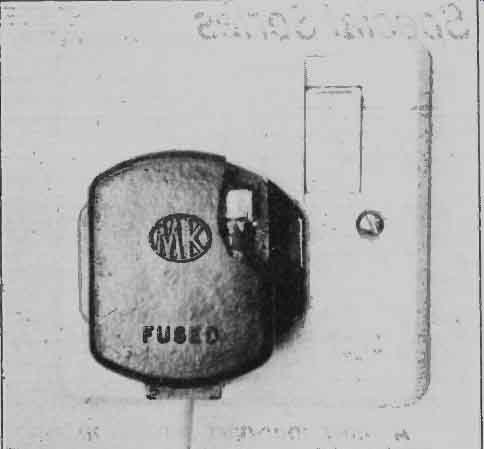
-------Never use a cracked plug—it’s lethal.
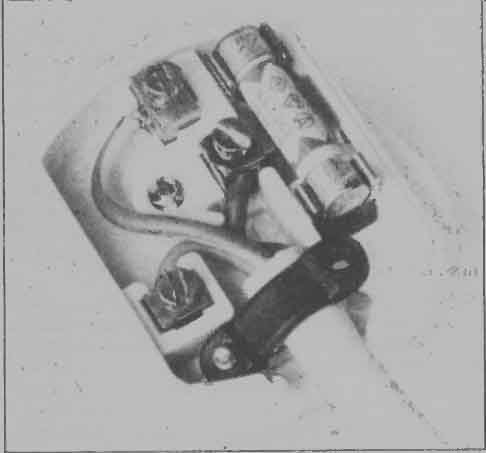
------Poor cable gripping, no strain relief for wires.
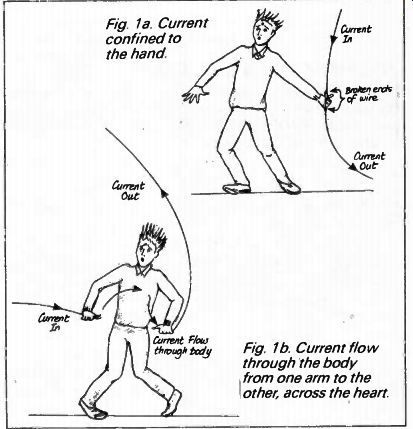
Fig. 1a. Current confined to the hand. Fig 1b. Current flow through the
body, from one arm to the other, across the heart.
PHYSIOLOGICAL EFFECTS
Electric shock is caused by current flowing through the body--that is the person becomes part of a circuit. The effect may be harmless, painful or lethal depending on the strength of the current and the path it takes. For example, a shock confined to the hand or arm (see Fig. 1a) is likely to have less effect than one which passes from one arm to the other with the heart between (see Fig. 1b). It is also particularly dangerous for the path of the current to involve the brain as when a live overhead wire is brushed by the head.
Electric shock can cause pain, unconsciousness, cessation of breathing and/or heart activity with consequent death. Suffocation is the most common cause of death in electric shock cases. Electric shock affects the nervous system and can cause violent muscular contraction with subsequent injury. Table. 1 shows the likely effects of different magnitudes of current in a person. Note that current is measured in amps (A) but here small currents are involved so it is more convenient to talk about milliamps (mA) (1A = 1000mA)
Note that we have made no distinction between the effects of a.c. (alternating current) and d.c. (direct cur rent). These differences exist but are too specialized to be discussed here.
Table 1: Shock Effect
Current (mA) | Effect
up to 1 | No effect.
1 Just detectable.
5 Some pain- muscle spasm.
10 Severe pain and muscle spasm.
30 Respiration ceases.
75 Heart stops, breathing stops.
As a general rule, any current over 20mA to 25mA may be regarded as potentially lethal. This may seem very small compared with, for example, the current flowing through a 240V 60W electric lamp which is 250mA. A shock sufficient to cause muscle contractions can "throw" a person with considerable force and possibly cause indirect injury. This reflex action can sometimes save life by clearing the person from the cause of shock.
Unfortunately, the same reflex action can sometimes cause the person to grasp the conductor more tightly so increasing the effect.
In Victorian times small electric shocks were said to be "healthy and wholesome". Electric shock machines were sometimes installed at fairgrounds with a control knob to increase the effect to the point where the subject could stand it no further! Until fairly recently, small induction coils--"shocking coils"--were sold at toy shops and these could increase battery voltage to a level where quite unpleasant shocks could be delivered between two handles held one in each hand.
Strangely enough, very large currents (in excess of 1A) are more likely to be survived than those around 75mA but these will not occur in a domestic situation.
USING OHM'S LAW
Ohm's Law can be applied to an electric shock because the human body conducts electricity. To predict the current we can use the following version of Ohm's Law which states: I = V/R
Where I is the current in amps, V is the voltage of the supply and R the skin contact resistance.
Some typical values of skin contact resistance are given in Table 2. It can be seen from the above equation that the current will be greater if (a) the voltage is higher or (b) the skin contact resistance is lower. Most people realize the significance of a higher voltage--that is, the higher the voltage the more danger exists but forget the equally important point of skin contact resistance.
Thus, the current flowing can be lethal with a relatively low voltage supply if low skin contact resistance is present. Conversely, a fairly high voltage may cause only a small effect if the hands are very dry ("high resistance") and only brushing contact made with the live conductor.
The highest "safe" voltage--that is, where live conductors can be handled without taking any particular precautions, is the value which will not drive a harmful cur rent through the body when the skin contact resistance is as low as possible. There are several interpretations of regulations and statements of good practice on this point.
If we take 5mA to be the greatest "acceptable" current (see Table 1) and five kilohm (5k(2) as the lowest likely skin contact resistance (see Table 2) it follows that the highest "safe" voltage will be 25V and this is a good figure to remember.
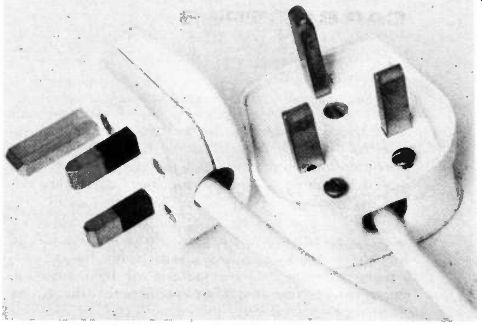
---------Old 13A three-pin plug and new Sleeved-pin plug.
CURRENT AFFAIRS
The skin contact resistance depends on several factors chief of which are the tightness of grip, the area of con tact and the presence of moisture (especially salty water as with sweaty hands). The resistance in each case will vary from subject to subject but the figures in Table 2 may be regarded as typical.
Table 2:
Situation | Resistance (k-Ohm)
Dry hands, light contact
Dry hands, tight grip
Wet hands, tight grip
Hands wet with salty water
100 20 10 5
Where mains voltage is used (240V in the UK), then applying Ohm's Law to the above resistance figures, the respective current values are: 2.4mA, 12mA, 24mA and 48mA. Referring to Table 1, it seems that the presence of moisture on the skin is likely to result in a lethal shock.
On building sites, portable power tools are often operated from a transformer providing a 110V supply.
Thus, even if contact were made with wet hands, the current through the body would be approximately:
I = V/R = 110/10000 = 11mA
Although extremely unpleasant, the victim would probably survive. In fact, this is not the whole story--the greatest voltage likely to be encountered is only half of this--55V--and we shall see how this comes about next month.
CAR BATTERIES
Consider a standard 12V car battery. If a person were to hold its terminals with wet salty hands (the worst case), the current will be:
I = V/R 12/5000 = 2.4mA
This could possibly be felt but would be unlikely to have any serious effect. Remember, this is the worst condition and, in practice, it is unlikely that any shock would be felt as a result of touching car battery terminals. Car project articles in EPE often advise the constructor to disconnect the battery and remove it before installation work begins. This is not because of any appreciable danger from electric shock but the possibility of burning and fire and this will be discussed in Parts 3 and 4. You should however note that the battery must not be disconnected when the vehicle is fitted with a coded audio system (unless you can reprogram the code) or when the engine management electronics may need resetting (as in some top of the range BMWs). This resetting can only be undertaken by the manufacturers service centre so "check before you disconnect". Where otherwise safe mains-operated power supply units do not exceed 12V to 16V output, it is highly unlikely that any detectable shock will be given by touching bare conductors even under the "worst" conditions.
In normal use, with dry hands, it will probably be safe to use supplies up to some 30V. Remember, however, that if a number of 9V batteries are connected together in series, a potentially lethal arrangement is soon reached--experimenters beware! Bulk electricity is distributed around urban areas at 11,000V. A shock from this, even with dry hands and light contact (skin resistance = 100k-Ohm) will be lethal because Ohm's Law predicts that the current to be: 1 = V/R = 110mA Electricity is carried over the countryside at up to 400,000 volts. If a child flies a kite into these wires (even though the kite string is normally regarded as being made from insulating material) sufficient current will flow to cause death. For example, suppose a trace of dampness produces a resistance of 10M-ohm, the current would be:
I = V/R = 400,000/10,000,000 = 40mA
Which is lethal.
TAKE CARE
Summarizing, to avoid electric shock in experimental work, everything must be kept dry and contact with ex posed wires at a higher voltage than 25V or so avoided.
Often the operating voltage is imposed by the design--mains voltage, for example, so it is necessary to concentrate on the other factors.
Reasons for accidental contact with live conductors are: frayed or spilt insulation on cable; wires partly pulled out of connectors; poorly-made (for example taped) joints; ex posed terminals and poking metallic objects into electrical apparatus. These situations are easily avoided by adults but special thought must be given to children.
There is particular danger when using equipment where the connecting wire rubs against the work surface during use. Soldering irons come into this category as do standard household electric irons. Over a period of time the rubbing removes the relatively hard-wearing outer sheath (see photograph). At the first sign of this happening, the wire must be replaced otherwise the rubber will wear through eventually exposing the copper conductors.
In the case of an iron, the exposed live wire will perhaps touch the metalwork of the ironing board and the user will receive a shock when he or she touches it. Sometimes a hot soldering iron bit is left resting on the mains wire and it burns through the insulation exposing the wires underneath. Again, reasonable care and frequent inspection will reveal the problem before danger exists.

------ Worn fabric wire can be very dangerous.
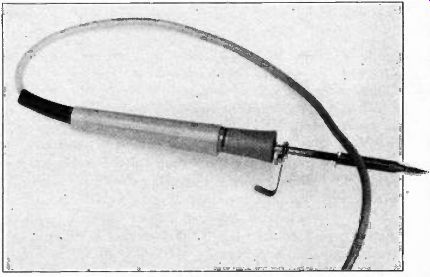
----- Avoid burning the soldering iron lead.
TIME FACTOR
Injury is caused to the individual because electricity is a form of energy. When any form of energy is released quickly it is likely to cause injury (for example, dropping a heavy weight on your foot). There is also a time factor involved. That is to say, if the current through the, body passes for less than a certain time--lets say, a few milliseconds--it will be much less dangerous than if it flows continuously.
Sometimes a sharp shock is given when a water tap is touched after walking on a nylon carpet or similar situation. This is caused by a build-up of static electricity. The voltage is very high--perhaps several hundred volts--and the current correspondingly high but it only passes for A short time and so is generally harmless. Note that "static electricity" does not give a shock as many people suppose.
Once it is moving through the body it is the same as any other electricity. In industry, large-scale generators of static electricity are regarded as dangerous and treated with respect.
That's all for this month. Next time we shall continue with our discussion on electric shock, some further safety points and checks needed to stay clear of trouble.
(adapted from: Everyday Practical Electronics, Dec. 1993)
Also see: Part 2